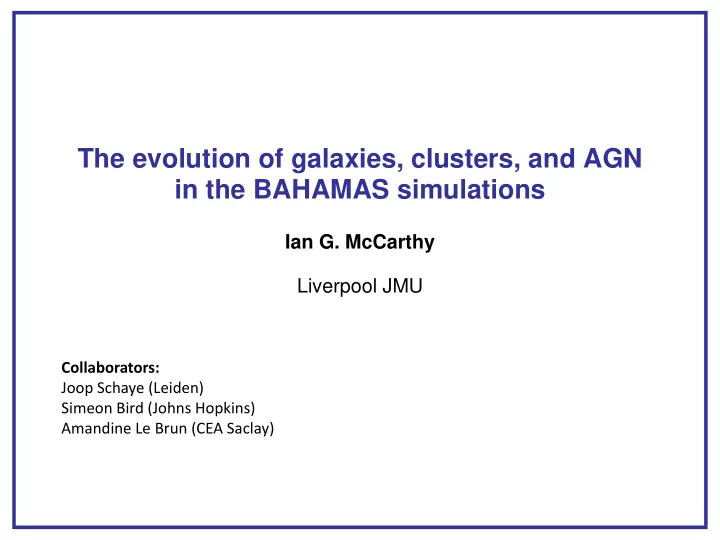

The evolution of galaxies, clusters, and AGN in the BAHAMAS simulations Ian G. McCarthy Liverpool JMU Collaborators: Joop Schaye (Leiden) Simeon Bird (Johns Hopkins) Amandine Le Brun (CEA Saclay)
IGM+2011 Role of hydro simulations • Allows one to make self-consistent predictions for galaxies, gas, total matter. • Can make synthetic observations useful for testing observational methods and simple models. BUT!: Our trust of sims linked to their realism. Finite resolution limits us to simplified treatments of important processes that occur on small scales. Simulations cannot robustly predict stellar or gas content of dark matter haloes CALIBRATION
IGM+2016, MNRAS BAHAMAS: BAryons and HAloes of MAssive Systems Distribution of stellar masses Hot gas masses First hydro simulations to reproduce the observed baryon content of collapsed structures. Realistically captures suppression of matter power spectrum.
IGM+2016, MNRAS Stellar mass fractions: centrals and satellites f star -M 200 for centrals cents vs. sats: f star,tot Reproduces SHAM and HOD modelling results fairly well.
IGM+2016, MNRAS Spatial distribution of stellar mass Stellar density profile: clusters Stellar mass autocorrelation function
IGM+2016, MNRAS X-ray scaling relations L X -M 500 Y X -M 500 Simulations processed through synthetic X-ray pipeline. Comparison to local X-ray-selected systems. Simulations reproduce L x -M 500 and Y x -M 500 relations automatically.
IGM+2016, MNRAS SZ scaling relations SZ-M star SZ-M 500 Compute SZ fluxes in an observational manner (within correct aperture; stacking in bins of stellar mass in right panel). Simulations reproduce well.
IGM+2016, MNRAS Spatial distribution of hot gas in clusters Gas density Also reproduce the detailed thermodynamic profiles over a wide range of radii and halo masses.
Evolution of galaxies
IGM+2016, MNRAS Evolution of cosmic stellar mass density • Broadly reproduces data when using observationally- motivated aperture • Diffuse light becomes important at late times • Completeness an issue for observations at z ≈2
IGM+2016, MNRAS Evolution of galaxy stellar mass function Qualitatively agrees with observed evolution (Muzzin+2013). Low -mass galaxies are overabundant (stellar masses too high), due to resolution. Slight underestimate of masses of most- massive galaxies at z > 2.
IGM+2016, MNRAS Evolution of cosmic SFR density • Qualitatively sensible, but overpredicts late-time SFRd and slightly underpredicts peak. • Similar level of agreement as EAGLE.
IGM+2016, MNRAS Evolution of sSFR-stellar mass relation
Evolution of clusters
Mummery+2016, in prep Evolution of abundance of clusters
Aside: A better way to do cluster counts? Velocity dispersion function (N FOF > 5) Velocity dispersion counts (N FOF > 5, σ v > 300 km/s ) Caldwell, IGM, et al. 2016, MNRAS
Barnes+2016, MNRAS Evolution of hot gas scaling relations M gas -M 500 T X -M 500 Y X -M 500 L X -M 500
Barnes+2016, MNRAS Evolution of hot gas profiles Gas density profiles Pressure profiles
Dynamics of IGM+2016, MNRAS satellite systems • Satellites evolve self-similarly. • But have negative velocity bias with respect to DM. Caldwell+2016, MNRAS
Evolution of AGN
IGM+2016, MNRAS Quasar luminosity function
Summary • BAHAMAS is a first attempt to bring the calibration philosophy to larger systems, with particular emphasis on large-scale structure cosmology applications. • Calibration is done at z=0 on the GSMF and the gas fractions of groups and clusters. A very simple physical model. No examination of evolution during calibration. • We have 12 different 400 h - 1 Mpc boxes with different cosmologies. Light cones with synthetic X-ray, SZ, cosmic shear, CMB lensing maps and corresponding galaxy and cluster catalogs are already complete. Cross-correlations with galaxies? • BAHAMAS qualitatively recovers observed evolution of massive galaxies and groups and clusters , even though its aim was mainly focused on LSS applications. There are differences in detail (especially SFR evolution), which an be used to be further constrain feedback model (and/or higher resolution required). • Hot gas properties of clusters, and especially groups, do not scale self-similarly in general (see Amandine’s talk next). But the dynamics of satellite population do.
Title
Recommend
More recommend